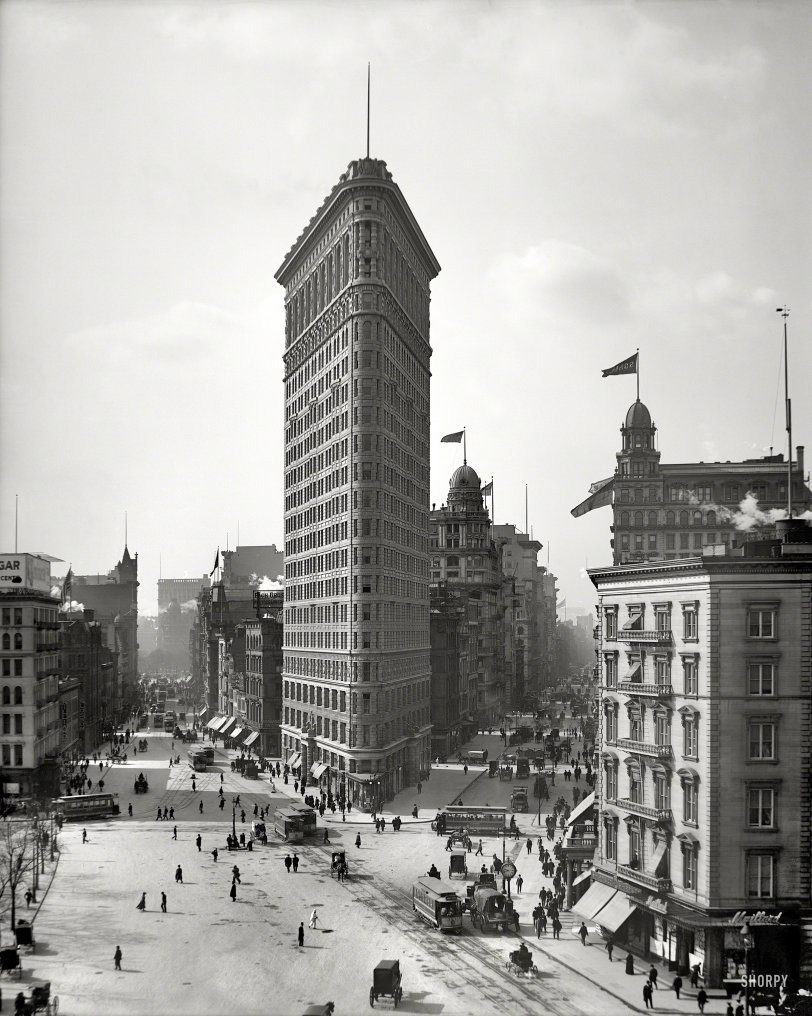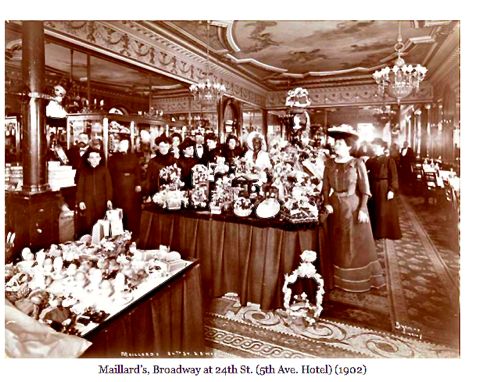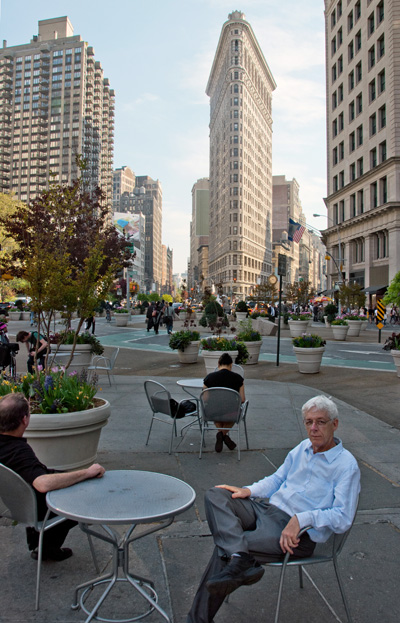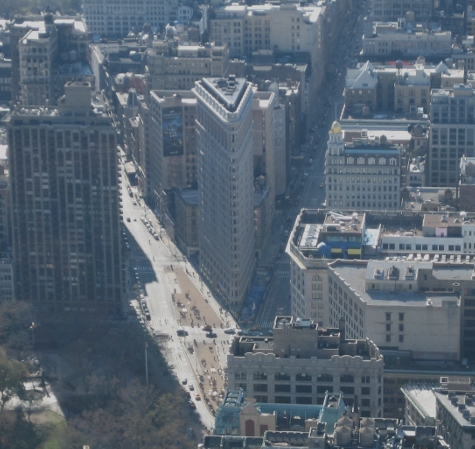


Framed or unframed, desk size to sofa size, printed by us in Arizona and Alabama since 2007. Explore now.
Shorpy is funded by you. Patreon contributors get an ad-free experience.
Learn more.

- Lofty addition
- In 1912
- Keenan Building
- Six years old
- Taken from the P.J. McArdle Roadway?
- It stood only 47 years
- Three track mind
- Incline to the right
- Reach for the sky, 1912 style
- No clean sweep
- Same Job Title, Same Face
- Sadly Lost
- Beautiful ...
- Where you get your kicks
- Aim High
- Pueblo Revival sisters
- Pueblo Neoclassicism
- Milk Man
- Regional dialect.
- Spielberg's inspiration
- Great Photo
- Loaf Story
- Do you still have the Rakes category?
- Could almost be a scene from the 1957 movie 'Hell Drivers'
- The Wages of Fear.
- Conspicuous by their absence
- Got Milk?
- All that aluminum
- No lefties
- Smoke 'em if you've got 'em
Print Emporium
Three Sides to Every Story

New York circa 1903. "The Flatiron Building." Topping the list of favorite triangular skyscrapers. Detroit Publishing glass negative. View full size.
Maillard's
At the lower right of this picture is the Maillard Candy Shop. It was in the 5th Avenue Hotel one block north of the Flatiron Building. I found this interesting article on Google:
Mr. Maillard came to the States from France in 1848, opening his first store at 401 Broadway, NYC. A Maillard’s shop was a tenant at the Fifth Avenue Hotel, eventually evolving from a confectionary into a ladies’ restaurant. In 1908, after the Fifth Avenue Hotel was demolished, a much larger store and ladies’ luncheon restaurant opened at the southwest corner of Fifth Avenue and 35th Street. The decor was Louis XVI, the ceiling was graced with lovely paintings, and the settings were completely French. Mr. Maillard, whose award-winning chocolates were exhibited around the world, furnished the inaugural banquet of President Lincoln, thereby making himself a household name. The shop was renowned for chocolates, bon-bons, cocoa, and ice cream. Although Maillard’s has long been out of business, their advertisement and trade cards are still collectible items today.
I wish these photographs were scratch-and-sniff, because I’ll bet the fragrance inside the shop was heavenly. Have a chocolate day.
~ S.G. Rogers

Steamer
I think the lone automobile in the lower right is a steam powered Stanley, White or Locomobile. These firms all made runabouts of this type beginning around 1899. I find their products impossible to differentiate from any distance, but they all have a narrower, more upright stance than the curved-dash Oldsmobile. This one appears to be a four-seater, less common than the two-seat buggy configuration.
One more thing
I just noticed that the caption on the photo says circa 1903. The clock in front of the toy building was built in 1909, so this photo would date no earlier than 1909.
[Two different clocks. This clock is in front of the Fifth Avenue Hotel, and was removed when the building was demolished in 1908. The current clock was installed in the same location when the Fifth Avenue Building - now the Toy Center - was erected the following year. -tterrace]
Picture Spot
When I went to NYC for the first time last year, how could I not get my picture taken with the Flatiron Building? I mean, c'mon.

Horses
The danger of disease-carrying horse manure to public health (a knee scraped in the gutter might ultimately kill you)led to a drive in the late 19th century to get animal powered vehicles off city streets. This directly led to the rapid development of the cable and electric street railway industries, as many municipal governments mandated the end of horse-car lines as soon as possible. I stopped counting at 21 trolleys in the picture--imagine two horses pulling each. That's almost 1,000 pounds of manure in a few blocks.
Toy Building
The building on the bottom right, with the clock in front on the sidewalk, is 200 5th Ave. also known as the 5th Ave.Building. During WWI, the building became the home of the toy industry, hosting the annual Toy Fair, the industry trade show. Toy Fair was held there, and in an adjacent building until 2007 or so, when the buildings were sold. The iconic clock was the unofficial symbol for Toy Fair for many years, and was declared a historic landmark in the 1980s. I loved going to New York for Toy Fair, and a highlight of being in the "Toy Building" was seeing the Flatiron Building across the street. It's an awesome sight!
One automobile
The only horseless carriage I see in the photo is in the right foreground. Could that be the famous curved-dashboard Oldsmobile?
Squares in the Distance
The view is to the south. The wide road heading south-southeast (to the left of the Flatiron Building) is Broadway (an old Native American trail running the diagonally the length of Manhattan for about 11 miles). Six blocks down Broadway from 23rd Street (the street the northern tip of the Flatiron Building touches, with crosstown streetcars visible) is 17th Street. 17th is the northern border of Union Square, which is visible in the distance.
The wide road leading south (to the right of the Flatiron Building) is 5th Avenue. It ends at Waverly Place / Washington Square North (equivalent of 7th street) at Washington Square Park (not visible in the picture). On the far side of the Square/Park is NYU.
Durable domes
The two flag-adorned domes seen on the right may look particularly old fashioned, but both are still around today. The dome on the right is atop 170 Fifth Avenue, on the corner of 22nd Street, built in 1897. It housed the offices and showroom of the Sohmer Piano Company and is still called the Sohmer Piano Building even though it was converted into 12 full-floor condominiums in the late 1990's. The most recent unit sale was a couple of months ago, for the unit occupying the second floor. It went for $3.875 million. None of the other units are currently for sale. Sorry.
The dome just to the Flatiron Building's right is on top of 141 Fifth Avenue, which was built in 1900 as the headquarters of the Merchant Bank of New York. It too has been converted to condominiums, though with over 30 units the building's rather less exclusive than 170 Fifth. It does, however, have a penthouse which includes the dome. It sold a couple years ago for $12.9 million.
The Flatiron Building itself houses the Macmillan publishing company, with retail on the ground floor. Its narrow profile means that there is only about 5,000 square feet of space on each floor and many of the offices are oddly shaped. In fact, space is at such a premium that the men's and women's restrooms are on alternating floors. One advantage is that most offices have windows.
As originally constructed, the Flatiron building had 20 stories. Almost as soon as it was finished, however, the developers decided to add a penthouse. It might have been under construction at the time of this photo but isn't visible due to the low angle. As it would have been too expensive to extend the existing elevators, getting to the penthouse required taking an elevator to the 20th floor, and then getting on a different elevator or using the stairs for the one-floor trip to the penthouse. As far as I know it's still that way today.
In addition to its architecture, the Flatiron Building was noteworthy in another respect: it was one of the first large office buildings that was built on spec, in other words without any tenants already having signed leases.
The area shown here, usually called the Flatiron District, is thriving today, with office and retail rents at levels close to those in Midtown. Many software and other technology companies are drawn to the area.
With all those horses
It's not surprising that there at least four Department of Sanitation workers within the field of view, busily trying to keep up with the output of those animals.
With an average production of about 22 pounds of manure per animal, per day, the horse population certainly created job security within the DoS, but the advent of the automobile brought a swift change to that particular activity.

























On Shorpy:
Today’s Top 5